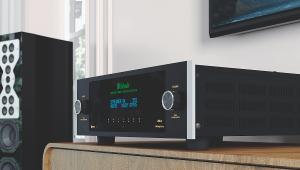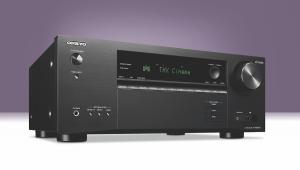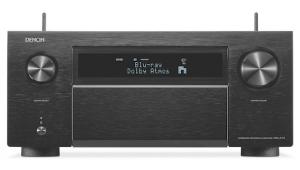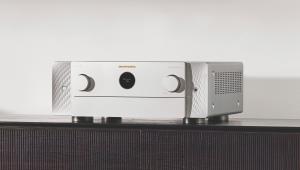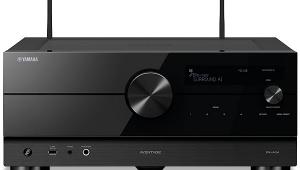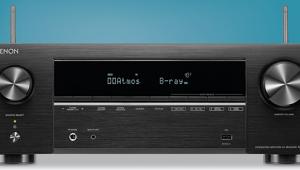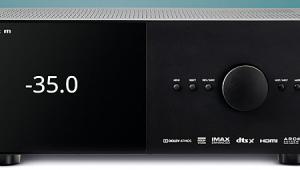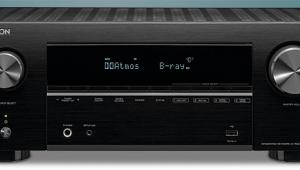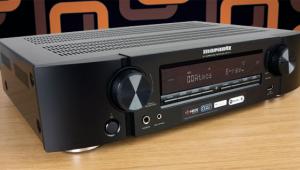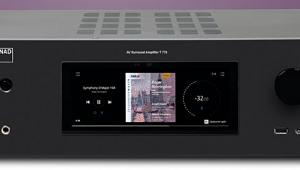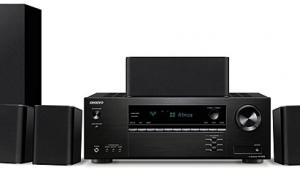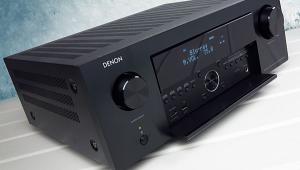Denon AVR-X1600H AV receiver review
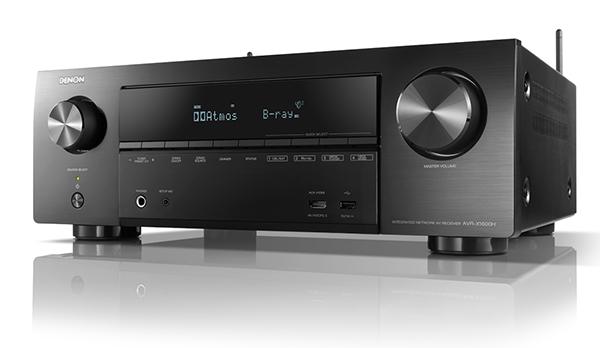
 Denon’s AVR lineup is designed to offer something for everyone. At the very top sits the £3,000 AVC-X8500H, a groundbreaking 13-channel model catering to expansive systems in dedicated cinema rooms. Drop down the range through 11-channel, 9-channel and 7-channel options, and eventually you’ll arrive at the AVR-X1600H. This is currently selling for almost a tenth of the price of its flagship sibling following a Black Friday price cut, but shares some of the same functionality.
Denon’s AVR lineup is designed to offer something for everyone. At the very top sits the £3,000 AVC-X8500H, a groundbreaking 13-channel model catering to expansive systems in dedicated cinema rooms. Drop down the range through 11-channel, 9-channel and 7-channel options, and eventually you’ll arrive at the AVR-X1600H. This is currently selling for almost a tenth of the price of its flagship sibling following a Black Friday price cut, but shares some of the same functionality.
Most obviously, it flaunts HEOS multiroom technology. This platform was first launched by Denon in 2014 with standalone wireless speakers, but it now extends to soundbars, AVRs and hi-fi separates, including from stablemate brand Marantz. And you don’t have to be a multiroom maestro to make use of it – the intuitive and generally stable-running HEOS app integrates access to subscription music services (Spotify, Tidal, Deezer, Qobuz, Amazon Music), plus internet radio, and works as a controller for the receiver’s Bluetooth, USB and networked audio playback, and as a handy source/volume changer.
In short, HEOS adds a whole level of extra functionality, while the inclusion of AirPlay 2 provides an alternative multiroom/streaming hookup for Apple devotees.
Denon AVR-X1600H features and design
The AVR-X1600H’s other features also impress considering the price. Physical connectivity includes six HDMI inputs (one front-mounted), backed up by composite AV and digital optical audio ports. There’s only one HDMI out, but it's hard to imagine prospective buyers demanding two – nor is the loss of a component video connection (found on Denon’s step-up X2600H) a deal-breaker. More useful (certainly as a future upgrade path) is the provision of twin subwoofer outputs, and the receiver’s MM phono turntable input.
The design is typically Denon, meaning the AVR-X1600H looks a lot like the AVC-X8500H, only smaller in stature and without a drawbridge to hide its setup mic and full-size headphone output, front-facing HDMI and USB ports, and control buttons. So while that does make it a little messy, the LCD display is pleasingly large, and the brushed finish gives it an air of glamour.
Internally, the receiver employs a seven-channel discrete amplifier stage claiming 80W per channel into 8 ohms (20Hz-20kHz measurement, 0.8% THD, two channels driven). Compared to the AVR-X2600H, that means a drop of around 15W per channel.
Of course, it’s probably not worth getting hung up about power claims when considering affordable receivers likely to be partnered with affordable speakers in a small/mid-size setup. For its likely end user, this Denon clearly has the juice available.
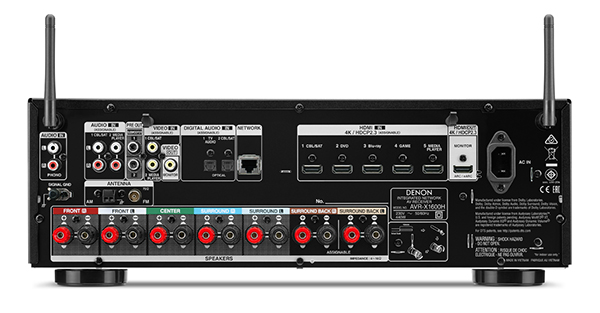
The AVR-X1600H is probably best thought of as either a cutting-edge replacement for a previous budget AVR, or a step-up from a soundbar/TV audio system. Regards the former, the provision of Dolby Atmos and DTS:X playback, and 4K HDR passthrough over HDMI (including Dolby Vision) – plus the aforementioned HEOS skills – make it easy to recommend if such features are in demand. As for the latter, anyone coming from a stereo soundbar to fully fledged multichannel audio is going to love it.
The seven-channel design enables 5.1, 7.1 or 5.1.2 Atmos setups, with Audyssey MultEQ XT to provide a level of room EQ and Denon’s setup assistant to guide you through the installation process. The latter is useful, as it runs logically and allows you to skip sections if you want (and you can return to it later on if you wish). The presentation, which majors on low-res text, isn’t very flash though – the GUI on the Marantz NR1710, for instance, is slicker.
Denon’s well-spaced binding posts don’t make bare wire connections too fiddly.
Audyssey MultEQ XT won’t excite committed calibrators, but it’s always recommended to run the setup, especially if the placement of your speakers doesn’t conform to ITU guidelines (which will be the case in many living room environments). The impact on my 5.1.2 sub/sat array, post-Audyssey, was a tighter overall soundfield. During playback, centre and subwoofer level adjustments are provided – the former useful to boost dialogue – plus treble/bass tone control.
While a lot of effort has been made to streamline the user experience, the number of available sound modes here (and their names) might still baffle. For instance, depending on the source, you might have up to nine different DTS variants to choose from. The Auto option (activated by the Pure key on the remote) is therefore a great fallback, as it matches source to channels. Denon has some fun with its presets too: hit the Music key on the handset (or the Sound Mode icon on the HEOS app) and you can scroll through to find Rock Arena and Jazz Club modes. The former really does make it sound like you’re queuing at the bar at the back of the venue and missing out on your favourite track.
Denon AVR-X1600H performance
The AVR-X1600H combines tangible amp power with a purposeful approach to sonic delivery. It’s a trait that first becomes apparent with stereo music playback. The funk basslines of Lenny Kravitz’s Always on the Run (Tidal, 16-bit/44kHz) benefit from the Denon’s love of the low-end, bringing a full-bodied feel to the sound, while Slash’s staccato guitar riffs play out and intertwine in the L/R channels. A criticism would be that the main vocal sounds a bit less forthright amidst the warm, rich tones; J.J Cale’s country meander Crazy Mama gives the receiver a chance to show more nuance. Meanwhile, Metallica’s well-produced Low Man’s Lyric absolutely stomps along, with the bass and snare drums hitting with a tight, dynamic punch.
This attacking approach benefits film soundmixes. In The Hitman’s Bodyguard (Blu-ray), when baddie Gary Oldman stabs someone through the hand with a pen (ouch), his sudden movement is accompanied by a thwack and a swell of the soundtrack, quickly followed by the squelch of tearing flesh. It’s designed to be unnerving and dramatic, and this budget AVR is up to the task.
There's no doubting the AVR-X1600H's ability to envelope with surround/Atmos content either. Audyssey calibration keeps a rein on proceedings, and the receiver steers and places FX believably. Even with its Atmos channel credentials maxing out at a modest 5.1.2, this can still be thrillingly immersive. Demo-grade sequences such as the Zero attack in Unbroken (Ultra HD Blu-ray), or the underwater finale in Aquaman, gain scale and depth with those two extra overhead channels (in my case, Dolby Atmos upfirers – Denon's amp assign tool lets you specify front/back Atmos and overhead/upfirer).
As with other 2019 Denon and Marantz hardware, the X1600H includes Dolby Height Virtualization processing, for an Atmos effect from a flatbed of speakers. And as I found with the Marantz NR1710, it's an idea that sounds better in theory than in practice. There's a notable shift in the sonic signature with the processing enabled, but it muddies the sound and affects clarity.
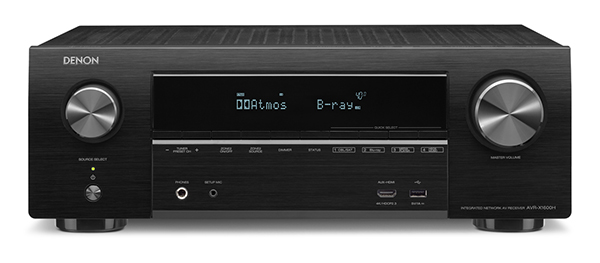
A more intriguing 2019 feature is Bluetooth transmission, which has only recently been made available via firmware update. This allows you to listen to your movies and music via Bluetooth headphones – which obviously has appeal for late-night sessions, family households, etc.
Put into practice with the John Wick: Chapter 3 – Parabellum and some inexpensive BT headphones, this feature proves extremely appealing. The film's multichannel mix is sent as a stereo downmix, but the intimate soundstaging offered by headphone listening means its retains plenty of effects localisation and immersion. As Wick sneaks around the Continental, fighting off invaders, the violence felt up close and personal.
The setup process is a bit counter-intuitive, there being no handset key for Bluetooth transmission – you need to activate it within the General Settings menu. Here you also have the option of simultaneously sending the native film mix to your speakers as usual, or only to your headphones (with volume control handled by the headphones). Denon says this flexibility isn't offered by any of its competition.
Denon AVR-X1600H verdict
Compared to pricier and more powerful AVRs, the X1600H obviously has some weaknesses. Its delivery sounds livelier as you push up the volume, but with my Focal Sib Evo Atmos package I found it easy to sometimes ask it to do too much, causing the sound to become hard and strident. Its multichannel delivery also lacks that sense of absolute cohesion and spaciousness that step-up models deliver.
Against that, however, there's this amp's price tag and feature set to consider. Sure, it's UI could do with a resolution spit and polish, and theres no Chromecast audio built-in, but with its HEOS integration and Bluetooth transmission features, the X1600H has two killer apps that have genuine user benefit. Additionally, some of the extra features offered by the X2600H (currently £450) – ISF certification, 4K upscaling, more analogue AV connections – are likely to remain unused. This is superb value for money.
 |
Home Cinema Choice #351 is on sale now, featuring: Samsung S95D flagship OLED TV; Ascendo loudspeakers; Pioneer VSA-LX805 AV receiver; UST projector roundup; 2024’s summer movies; Conan 4K; and more
|





